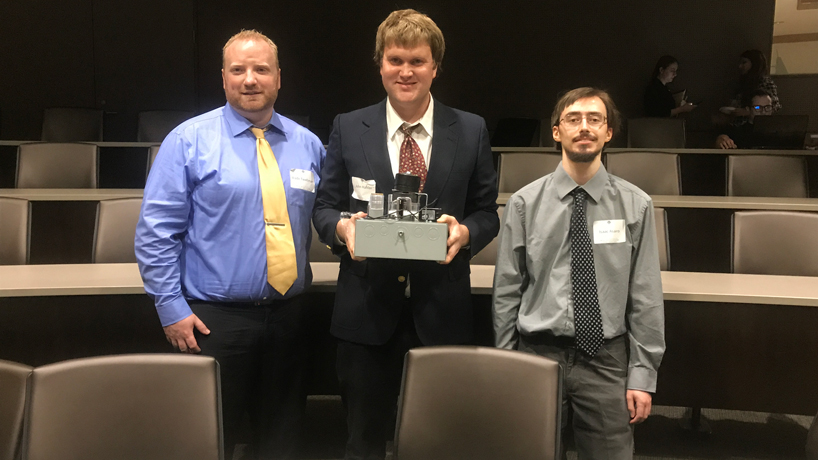
Mechanical engineering majors (from left) Wade Twellman, John Hahler and Issac Asaro present their media plate wrapping device at the Donald Danforth Plant Science Center in St. Louis. (Photo courtesy of Beth Miller)
Twenty seconds or less.
It’s a limited timeframe to complete just about anything, but a group of mechanical engineering majors retorted, “How does 15 seconds sound?”
This summer, 23 students in the University of Missouri–St. Louis and Washington University joint program developed designs and working prototypes to solve everyday issues for researchers at the Donald Danforth Plant Science Center as part of a capstone mechanical engineering design course.
Among the proposed projects was a media plate wrapping device, which would bind petri dishes with tape or plastic wrap in a matter of seconds and relieve lab technicians from doing it by hand. Teammates Issac Asaro, John Hahler and Wade Twellman tackled the 20-second challenge by creating a low-voltage device using an electrical box, hockey puck, constant pressure switch and custom-fabricated pieces.
When his team first received the assignment, Twellman questioned the necessity of such a device, but after covering several dishes, he quickly realized its value.
“I wrapped probably 150 petri dishes just sitting there, and I never want to wrap one again in my life,” Twellman said. “I completely understand the problem and the issue.”
The plate wrapping device was just one of the eight prototypes presented to researchers on Aug. 14 at the Danforth Center in St. Louis.
Before selecting the final projects, students evaluated 17 Danforth Center proposals. Through this partnership, the researchers hoped to push boundaries, solve problems and advance their research by utilizing new tools.
“Being scientists, we should not narrow down our perspective,” said Veena Veena, director of the Plant Tissue Culture and Transformation Facility. “We should remain open to other perspectives because together we can come up with new solutions, creative thinking and come up with better ideas and better outcomes.”
Other student designs ranged from a plant growth chamber to a lens mount system. Within the shortened summer semester, teams also met with a sponsor who provided lab tours and insight into how the projects would directly advance or streamline research.
“I really liked the partnership with the Danforth Center,” said John Jensen, whose team created a large chamber to test the distances seeds will travel in a user-specified windspeed. “You have a real problem. It’s not just, ‘Come up with a crazy idea for something and then make it.’ You actually had somebody with a defined list of requirements that you had to meet.”
Mark Jakiela, director of mechanical engineering in the joint program, also stressed the importance of solving tangible problems.
“These are real projects, and that’s critically important,” Jakiela said. “Students are getting real experience, working on real projects – not something that I conjured up and not something that we’ve done over and over again.”
More information on each of the projects can be found on Washington University’s open scholarship site. The full list of projects includes:















